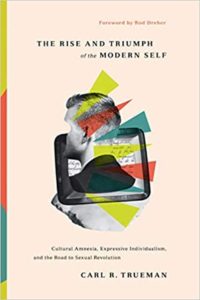 A few months ago I finished Carl Trueman’s book, The Rise and Triumph of the Modern Self. It is full of detailed, helpful explanations of the roots and causes that have led to some of the most powerful ideas shaping our culture right now. Near the beginning of the book, he writes:
A few months ago I finished Carl Trueman’s book, The Rise and Triumph of the Modern Self. It is full of detailed, helpful explanations of the roots and causes that have led to some of the most powerful ideas shaping our culture right now. Near the beginning of the book, he writes:
What past times were better than the present? An era before antibiotics when childbirth or even minor cuts might lead to septicemia or death? The great days of the nineteenth century when the church was culturally powerful and marriage was between one man and one woman for life but little children worked in factories and swept chimneys? Perhaps the Great Depression? The Second World War? The era of Vietnam? Every age has had its darkness and its dangers. The task of the Christian is not to whine about the moment in which he or she lives but understand its problems and respond appropriately to them.
If you want a deep understanding of why people think the way they think in 2021 America, Trueman’s book is the place to start. It’s not a light read, but it’s not boring or dense either, and it’s absolutely worthwhile. I wanted to post an excerpt, and was having trouble finding something that really summed up the book, so I decided to share one particular insight I gleaned from it instead. One of the concepts Trueman discusses early on is the idea of a “deathwork,” which is a term that was coined to describe a certain kind of work of art, or anything a culture produces, really, that is an indication of an unhealthy culture, to say the least. Trueman notes that deathwork has been defined as anything that represents “an all-out assault on the objects of its admiration.” When you look at, or contemplate, a deathwork, it assaults you. You might think this sounds a little over-the-top, until you really get into the concept, and then I think what occurs to you is something more like, “Oh, I see this all the time.”
For instance, Trueman notes the idea that cultures are made of, and defined by, what they forbid. The result of this forbidding is that certain drives or desires are frustrated, and, as the theory goes, “the frustration that such rules create finds an outlet in art; thus, works of art are also constitutive of the culture, reflecting in some way the [prohibitions] that are in place. A deathwork, by contrast, represents an attack on established cultural art forms in a manner designed to undo the deeper moral structure of society.” The art, or any creation, that can be called a deathwork is not an expression of some deep reality from within the boundaries of a culture, it is, instead, an attack on the whole culture.
Trueman continues:
Deathworks make the old values look ridiculous. They represent not so much arguments against the old order as subversions of it. They aim at changing the aesthetic tastes and sympathies of society so as to undermine the commands on which that society was based.
The highest authority of the [older] world, God, is literally cast into the sewer, the lowest of the low. The sacramental is made into the excremental. And just to be clear – this is not simply an assault on the private religious sensibilities of Roman Catholics; it is an assault on the very authority, the sacred order, by which second worlds are legitimated. Its power lies not in any argument it proposes but rather in the way the clean is subverted by the vile. Religion is not rendered untrue. It is made distasteful and disgusting. [p. 96-97]
Reading the passage above, listening to Trueman dig deeper and deeper into the idea, I was struck by how much of what our culture creates, from “high” art to our popular entertainment, from music to most of what’s on YouTube, is exactly this–it’s not a celebration of beauty, it’s an attack on beauty, and the very concept of beauty. Why do recording artists sing about death, and abuse, and exploitation? It’s an attack on the idea of human dignity, of the true relationship, of friendship, of any purpose in life beyond momentary pleasure at the expense of others. It is not meant to give any kind of life at all–it’s a deathwork.
I think that last two sentences of the quote above are key for understanding the moment we Christians occupy. “Religion is not rendered untrue. It is made distasteful and disgusting.” A moment’s reflection will reveal how true this is for us. By all means, let us study apologetics–let us be able to answer any and every question and objection from an honest inquirer or obstinate adversary. But let us also be aware that, more likely than not, whenever we’re in any kind of public space, we will typically not be involved in intelligent dialogue with skeptics. Instead, we will simply be dismissed, ignored, or ridiculed by the culture around us. After all, the idea goes, you don’t dialogue with someone who’s not worth talking to, especially if they’re evil. To get into a conversation would be to lend legitimacy to their ideas.
The entire book works through these themes to help us understand the lay of our land. And just to be clear–it’s not depressing at all. It’s bracing and clarifying, but then, Christians should never be afraid to be open-eyed about their world. We have nothing to be afraid of. And besides, Jesus has love to extend to everyone around us. He’s got this.
Trueman ends his book with a few brief reflections of how Christians might think and move forward in faithfulness. The church, he says,
should reflect long and hard on the connection between aesthetics and her core beliefs and practices. I noted above that one of the hallmarks of ethical discussion today is its dependence on personal narratives. Our Bodies, Ourselves, the feminist bible, is full of personal testimonies presented as incontrovertible precisely because they are personal testimonies – highest form of authority in an age of expressive individualism. And this aesthetic concern reflects the perennial power of sympathy and empathy in shaping morality…
We lived today in a world that embodies the culmination of this tendency… [A] central characteristic of our contemporary culture is the impoverishment of ideas as a driving force of cultural life. Today images have primacy over ideas. For that reason, cinema, television and now the Internet have left books to one side…
The church needs to respond to this aesthetic-based logic, but first of all she needs to be consciously aware of it. And that means that she herself must forgo indulging in, and thereby legitimating, the kind of aesthetic strategy of the wider culture…
If the church is to avoid the absolutizing of aesthetics by an appropriate commitment to Christianity as first and foremost doctrinal, then second, she must also be a community…
This makes Christianity look highly implausible at the current time. If the message about the self is that of expressive individualism or psychological man, and if that message is being preached from every commercial, every website, every newscast, and every billboard to which people are exposed on a daily basis, the task of the church in cultivating a different understanding of the self is, humanly speaking, likely to provoke despair.
Yet there is hope: the world in which we live is now witness to communities in flux. The nation-state no longer provides identity, as the globalized world makes it seem impotent and ineffective and as decades of being told in the West that patriotism is bad have taken their tolls on the social imaginary. Many cities are anonymous places, and suburbs function as giant commuter motels. The loss of commercial town centers and the rise of the internet have detached people from real communities. Now bizarre phrases such as “online community” and “he pledged allegiance to ISIS online” actually make sense because we know how the very idea of community have been evacuated of the notion of bodily proximity and presence…
One might indeed be tempted to despair at this point if it were not for the fact that human beings still need to belong, to be recognized, and to have community…And communities shape consciousness. There is a reason why Paul comments in 1 Corinthians 15:33 that bad company corrupts morals. Our moral consciousness is very much shaped by our community. And for this reason, the church needs to be a strong community. Yes, this may be hard in an era when the proliferation of denominations and churches had made ecclesiastical commitment potentially just one more form of consumer choice. But we have no power to change that general context, and we cannot allow it to excuse us from behaving in a community. [p. 403-405]
This is just a taste of the book. Look, it’s February. We’ve still got plenty of those rainy 40-degree days ahead, and maybe even a couple of our signature March snow dumps. It would be worth your time to hit up the bookstore, or Crossway’s website, and grab a copy to read before the Summer really gets into full swing.
